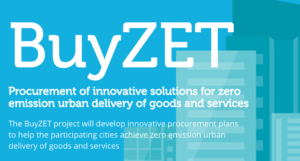BuyZET is a Horizon 2020 project that looks into the procurement of innovative solutions for zero emission urban delivery of goods and services. Representing typically 10 to 20 percent of GDP within EU member states, public procurement is seen as a powerful tool for driving demand and acting as a key launch customer for innovative products.
On the organizational level, more and more it represents a strategic instrument for helping to meet specific policy goals of the organization through its influence on supply chains, and not simply as an administrative function.
The main goals of the BuyZET project are:
- To boost demand for zero emission vehicles (ZEVs) and other zero emission urban delivery solutions on the European market;
- To develop procurement plans to achieve zero emission urban delivery of goods and services to the public sector, and thereby improve quality of life in European cities by:
- Minimising the number, distance and disruptiveness of motorised vehicle trips within the city,
- Maximising the proportion of those trips made by zero emission vehicles.
Activities
The project concept is realized by a set of activities that are applied in five participating cities: Rotterdam, Oslo and Copenhagen, as key project cities, and Brussels and Southampton as observer cities. These activities are:
- Developing a more complete understanding of the transportation footprints of all types of goods and services delivered to the public sector in the cities;
- Undertaking extensive market engagement and other research activities to identify alternative solutions for achieving zero emission delivery of goods and services in identified high-priority procurement areas;
- Identifying other potential public and private sector buyers and the regional, national or international level for the formation of buyers groups;
- Developing procurement plans for these areas in co-operation with the buyers groups.
Mapping methodology
WP2 “Mapping of procurement transportation footprint and prioritisation of procurement categories” delivered a general draft approach for the mapping of the emission footprint of municipalities (Deliverable 2.1), which will soon be published. While mapping the transport footprint of a municipality, it is necessary to identify and encompass all activities performed by municipalities that produce any transport activity. In the BuyZET project these activities are divided into three categories, differing according to the transport ownership and type of service provided. Both has an impact on the degree upon which municipality has an influence on the provision of the service and therefore on the transport footprint of this service.
These transport service categories include :
- The services performed by municipality with its own fleet (category 1);
- Procurement of services for which the transportation of people or goods is the central component but which are performed for municipality by a third party provider using the third party provider’s transport fleet (category 2);
- Procurement of goods, works and services which involve an element of transportation of people or goods which are performed for municipalities, by a third party provider using the third party provider’s transport fleet (category 3).
Two-phase approach
The BuyZET mapping methodology is based on a two-phase approach. The main objective of Phase I is to get an overall big picture of what are the most emission intensive categories and, where possible, emission intensive procurement clusters. Accuracy is important as much as it can be achieved with the data available, as collecting data directly from suppliers is time consuming and cost intensive. In Phase II a deeper investigation on the emission intensive procurement clusters from Phase I is performed, resulting in more accurate and precise emission footprint. For that reason Phase II includes a more comprehensive data collection in order to understand all the specifics in the procurement category/cluster that emits the most. This is necessary in order to be able to identify the most appropriate strategies to lower emissions from these clusters. Phase II per selected procurement cluster is looking deeper in such indicators as, e.g., the frequency of trips, transport modes that trips are performed and other parameters that will help to assess the impact of zero emission decisions on disruptiveness of trips, congestion and other important for city characteristics.
The BuyZET methodology is founded on the traditional footprint calculation methods: fuel based, distance based and spend based methods. Depending on the data available these methods are used to map a footprint from different transport service categories.
BuyZET invites other cities to become observer cities in the project.
Source: BuyZET project.

